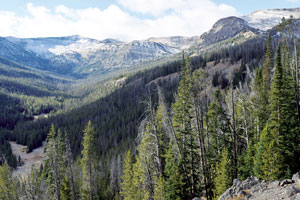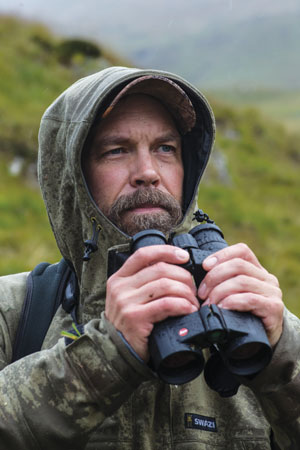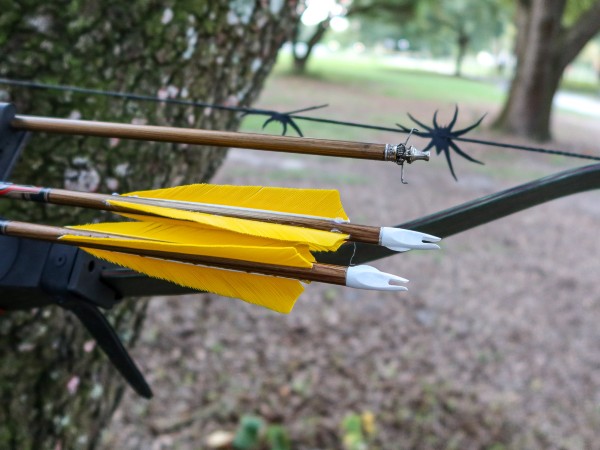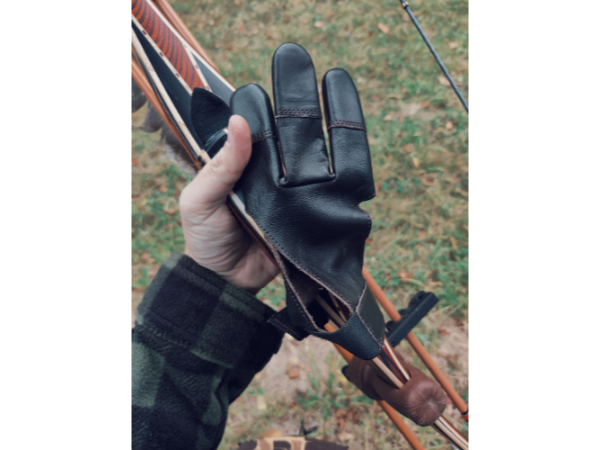Grizzly tracks paved the dusty mule trails, in places erasing all sign of the heavy camp traffic. As dusk pulled shadows from the forest, I saw my first elk print. We’d been more than 20 miles in the saddle when we dismounted and tugged panniers, then pack-saddles, into the tack tent.
 To find elk in big places, prowl timber on elk trails. Follow the signs. Stay quiet if the elk don’t talk.
To find elk in big places, prowl timber on elk trails. Follow the signs. Stay quiet if the elk don’t talk.
Above: Prepare for unseasonal weather! Besides showing tracks, snow can move elk, and affect rutting behavior.
Far away, plans to issue a handful of hunting permits to thin grizzly numbers in places over-run by the bears were about to collapse. We would lament that later. Now, on the evening of September 18th, we listened for elk but heard none.
Hunting meadow edges from our camp at 8,500 feet the next morning, we saw fresh rubs on burly young conifers, limbs raked high enough to show the bulls had ridden them down. But as an early squall pelted us with hail, then plastered the woods with wet snow, we neither saw nor heard an elk. My pal tried to rustle up a response to his bugle. Nada.
Storied elk country at the peak of the rut shouldn’t be silent. But when it is, you must adapt quickly. The next morning, we moved up-country to climb a timbered north slope. There was some activity, on our ridge and that opposite. We got close enough to hear elk walking. On the third day I explored more of that area, this time alone. Making less noise and without bugling, I saw several elk, one a bull 50-yards away. The ridge was coming into focus. Adjusting my route the next morning to take advantage of elk trails now familiar, I heard more elk, and closed within arrow range of a better bull.
While late September promises active elk, weather can shift the rut peak ahead or back. It can extend rutting activity or compress it. It can move elk from traditional cover into higher country or to transitional range. Like hunting pressure or the presence of predators, weather can also limit bugling, even when bulls are thrashing trees, bouncing off each other’s skulls, and dashing after hot cows.

Pack stock brings you where elk avoid other hunters. Stay unobtrusive, or they’ll move to avoid you!
From late August into October, hunters handy with a bugle or cow call can bring elk close often enough to justify calling. But elk always have choices when they hear your whistle. 1) They can ignore it. 2) They can reply and stay where they are. 3) They can reply and come. 4) They can approach silently. 5) Or, they can gather up their cows and leave. They may or may not think you’re an elk. One thing is certain: they know where you are. A bugle can, in fact, be an alarm bell.
In my view, bull densities greatly affect the frequency of responses. Crowds of noisy elk prompt more bugling—good news for archers like me, who hunt without calling. The occasional calf squeak after I stumble over a limb is all I allow myself. In 46 years of hunting with rifle and bow, I’ve shot only one elk called in. My friend brought this randy bull to us at a gallop over half a mile of mountain at the close of a dark, drizzly, otherwise silent day.
In productive elk country, you should see many elk that for various reasons you’re unable to kill. Rut shows you more of those animals, because rut spurs daytime movement. But, barring migration, the beasts are still in or near their late-September haunts before and after rut. They may be harder to find and approach, which means only that when you get a chance, there’s more hanging in the balance.
Elk, you’ve read, are grazers. True. That broad mouth belongs in grass, just as a deer’s slim snout fulfills its destiny by nipping tender shoots from tangles of brush. But you may find trampled meadows, even those pressed flat by bedded elk, empty. Especially when hunters prowl their fringes, elk use these areas mainly at night. Timber offers daytime security and, in warm weather, welcome shade. Oak brush, cedars, and picket-fence lodgepole pine define tough hunting—assurance that some bulls will mature! Other elk bed in jack-straw windfall, as it keeps many bowmen at bay and makes any approach audible. When all tracks lead to thick places, I pick my way into the easiest of them to hunt silently. Still-hunting where you often fail beats staring at vacant meadows. It’s more a test of woodsmanship than posting over water or wallow.
Ghosting through cover on elk trails, you’ll travel where elk expect to hear the sounds of other elk. Move like an elk, and your disturbance may be accepted as benign. Out of rut, few elk vocalize, so if you use that pipe, you draw attention. Also, because you don’t know who’s listening, you can only hope what you say and how you say it will help you. Should you cow-call, roar like an old bull, squeal like a young bull, thrash bushes like an elk furious with foliage, or bleat like a lost calf? Spotting a bull first can shorten your list of pick-up lines. But pitching him, you may also walk past and alert elk much closer!
Silence, on the other hand, is golden. It preserves your options and doesn’t help elk choose theirs.

High quality binoculars help you find distant elk. More importantly, they show you detail in cover at arrow range.
Chief among elk-hunting gaffs are acting too human and not listening enough. In promising cover, your main job isn’t to move, but to detect animals nearby. Your nose isn’t very sensitive, so will register elk scent only when the animals are (or have recently been) close, and the wind is right. You can see color that elk can’t, but don’t spot movement nearly as well. Your hearing isn’t as keen either, but if you put it to proper use, you’ll often hear elk that don’t bugle. After all, these are heavy creatures with hooves, and they’re gregarious. In thickets, my ears have put me onto elk as often as have my eyes.
The elk you hear best may not be your best targets. Once, a distant whistle drew me fast through crowded timber, and I all but ran up on a bull quietly munching forbs in a shaft of evening sun! With no plan and no cover, I could only throw myself flat. By great good luck, this elk was facing away. In time, I managed to close the gap. My Zwickey quartered forward, a hit quickly fatal.
To hear and see better, stop moving. Be still, stone-still. Unbroken stillness can deliver signals so faint the slightest disturbance blocks them. Many hunters pause short of a complete stop. They interrupt their step, but they turn to look about, shift weight from one foot to another, rock back and forth to peer around trees, fiddle with whatever’s in their pockets, change hands on the bow. All this draws attention while inhibiting your ability to hear or see. A wild animal with its radar up is still. While depriving you of clues, it readily detects your noise and movement.
Small sounds go undetected when drowned by your own circus of activity. Only motionless eyes catch motion. For the first few seconds during a stop, I don’t shift my vision or even inhale.
Once, alerted by hoof-falls on pine litter, I glimpsed an elk at 60 yards. Scooting from one ponderosa to the next, I made to intercept it. Alas, I ran out of cover right in its path! Sucking in my belly behind a 2-inch seedling no taller than a floor lamp, I could only watch as the five-point strode to within 15 feet. My bulk suddenly apparent, the bull gawked, spun, and galloped off. Had I halted shy of his route, I’d have had a wonderful chance.
Even when you don’t see an elk first, where you tarry matters. Elk that hold tight are most apt to lose their nerve and break cover at a pause. You’re smart to stop where you can shoot in several directions or at least reach lanes with a short step, bow limbs unhindered. You don’t need long alleys or expansive views when hunting with a bow, but 40-yard corridors are precious. You’ll also want to stop where you can stand comfortably and move your feet silently—no sun in your eyes, no backdrop emphasizing your silhouette, no barking squirrels. If vindictive rodents open up just as you pause, accept it as your luck for the moment. It will improve.

After a shot, ready another arrow immediately. Rutting or not, a bull may give you a second chance.
Binoculars bring distant objects close, and they also resolve crucial details within bow range. Low magnification helps in three ways: 1) It delivers a bright image (big exit pupil) through compact objective lenses (30 to 35mm), even in dark conditions. 2) You get a wide field of view, so you needn’t “pan” cover—a habit that denies you detail you’d notice with still glass. 3) You get a deep field of view, or acceptably sharp focus across a wider span of distance than possible with higher magnification. Keep that binocular high on your chest, so it comes up with minimal hand movement and is always ready to hand but doesn’t flop about. Frequent glassing encourages full stops.
Sending arrows accurately is more important when you have fewer shots. Last fall, a pal hosted a new archer on a hunt. They found a congregation of rut-goofy elk. In turn, the hunter launched arrows at five bulls, including two fine six-points, without result. My friend collected shafts from broadheads held fast by pines. Near day’s end, the pair spent 20 minutes digging a head free for one more shot.
Such fortune almost never blesses hunters before and after rut. But neither will all elk sprint off as soon as they identify you or hear the hiss of the grey goose wing. A corrected second shot should come naturally. Better to nock and release quickly than delay in hopes the animal will dismiss you as irrelevant. Thrice I’ve killed bulls with follow-up shots. One elk took a lethal hit while sniffing my first arrow, stuck in the hillside. Another, nicked by my Razorhead, paused after a jump to reconsider and got the next shaft through his heart.
The third bull offered an easy shot; but I had run to catch up with him and released hurriedly. The arrow buried in the ribs just back of the diaphragm. Inexplicably, this elk stood as I whipped another shaft onto the string. I sent it as the animal ran off—a shot I’d never have taken at an unwounded elk. Blood from that wound, foreleg crease to brisket, proved crucial to recovery.
When the forest is silent and your bugle no more help than a bell, you’ll want to make the most of every second chance.
-
A September pack train heads home from a remote Wyoming camp.
Prepare to hunt silently, even at “the peak of the rut,” which can shift.
Weather, hunting pressure, and predators can also silence rutting bulls.
-
Don Ward built the bow that took his first elk.
Bugling can help you in early fall…or warn bulls off.









Leave A Comment